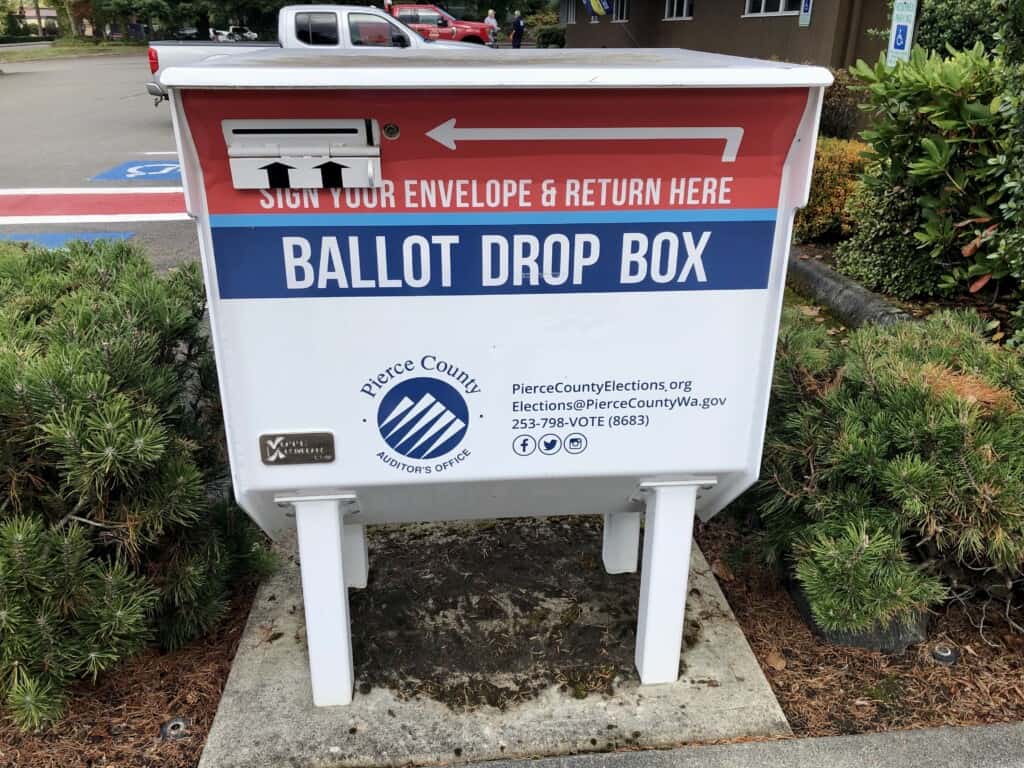Government
Gig Harbor Council 3: Lykins challenging incumbent Franich
Brenda Lykins is challenging incumbent Jim Franich in the race for Gig Harbor City Council Position 3.
Franich, a third-generation Harborite, served several Council terms before taking a break. He was re-elected in 2018 and wants to continue serving for another term because, he says, “I still care very deeply about this town and I want to do all I can to protect its beauty and the natural surroundings and eclectic character.”

Ballots can be dropped at boxes around the city. This one is at the fire station on Kimball Drive. Ed Friedrich / Gig Harbor Now
He’s also concerned about maintaining local control.
“There are outside agencies — state agencies in particular — that are looking to make big changes to our city codes, especially to our R-1 (single family residential) zones,” he said. “They’re looking to allow duplexes and triplexes and even some higher densities here. I think people who move here are here because they fell in love with how quaint our city is. And they want us to keep it that way.”
Franich is also paying close attention to the Commercial Aviation Coordinating Committee’s analysis of Puget Sound airports.
“We’re not interested in turning our airport into a big commercial hub,” he said.
Lykins and her husband have lived in Gig Harbor for six years, but have wanted to live here for much longer.
“We waited until our kids were out of school and grown up so they wouldn’t be disrupted,” she said.
Lykins is a “semi-retired” nurse practitioner who went back to work when COVID hit because she recognized the need during the pandemic.
“My husband and I have always wanted to be civically involved, and when the City Council meetings were switched to virtual meetings, we watched the meetings on Zoom at dinnertime,” she said. “I like to stay active and engaged and I want to be part of making our wonderful community even better.
“Gig Harbor needs representation from all its citizens, not just certain groups. We’re all taxpayers. One thing I’ve heard over and over again when I’ve been canvassing is that people want to have a voice at the table when it comes to issues that affect them. They want to be heard and respected. I like to see people who can bring consensus. I truly believe we can get things done when we work together. I believe that Gig Harbor’s best days can be in the future.”
Franich has raised $4,723 and spent $2,408 since he filed for office. Lykins has raised $8,663 and spent $3,834, according to the state Public Disclosure Commission.
On Sept. 30, Gig Harbor Now sent an identical questionnaire to each City Council candidate. We are printing their responses verbatim.
Jim Franich
1. Should city government facilitate the building of more affordable housing? How?
The first thing Council needs to do is define what is “affordable housing.” From there we can explore different strategies to address the issue. The City has recently become part of the South Sound Housing Affordability Partners (SSHAP) which is a group of cities that have come together to discuss affordable housing. I expect that some possible solutions will come from those discussions. Partnering with Habitat for Humanity on existing city-owned properties may be one solution to consider. But the challenge continues to be Gig Harbor’s soaring market values.
2. What can the Council do to maintain the city’s small, charming personality while adhering to the Growth Management Act and other growth pressures?
We must prioritize these competing interests if we value our town. The City is currently formalizing our most important planning processes right now. The Puget Sound Regional Council (PSRC) Vision 2050 sets future population allocations for our Gig Harbor for the next 38 years. This top-down regulatory policy will have a direct impact on our ability to maintain the City’s unique identity and small town appeal. As an EXPERIENCED member of the City’s Planning and Building Committee I am working very hard, together with staff, to protect the character of Gig Harbor.
3. Many city employees have been characterized recently as dissatisfied and have left their jobs. What can be done to reverse this trend?
We have completed the employee engagement survey and met with staff to analyze the results. We received some excellent feed-back. We will continue to build on those survey findings to make Gig Harbor a more attractive place to work. The average longevity of city employees is ten years; which is high by industry standards. People leave their jobs for a variety of reasons and the Covid Pandemic took its toll on city staff. The City offers very competitive compensation programs and Gig Harbor is a beautiful place to work.
4. How can city government assure that infrastructure keeps up with growth?
Our Wastewater Treatment Plant and Water System are in great shape. Transportation Infrastructure is in need of a lot of money. We have over $52 million dollars worth of projects on our Capital Improvements Project List. By maintaining and updating (when appropriate) our impact fees charges will allow us to help fund future Capital Projects and Operating costs. We have to plow as much money as we can into our Street Capital Fund if we hope to keep up and we must work to reign in project costs by consistently scrutinizing engineering estimates and bids.
5. What would be your top priority should you be elected or re-elected to the Council?
First and formost, I represent the people of Gig Harbor. What I’m hearing is that residents love our town. If we hope to preserve it, we must maintain LOCAL CONTROL. My experience as a seasoned City Councilmember provides valuable insights: building coalitions with other jurisdictions that feel the same can be very powerful. Together we can work with State representatives to ensure local control is maintained.
Brenda Lykins
1. Should city government facilitate the building of more affordable housing? How?
Affordable housing is a concern in Gig Harbor, as housing prices and rents have dramatically increased in the last few years. I have heard from city businesses that they are having a difficult time recruiting workers due to the high cost of housing in our area. I have also met with families that have faced unexpected delays and fees from the city when attempting to make construction renovations to support making space to accommodate an elderly family member of multigenerational household.
In Pierce County, housing needs are changing as one in five families in our county is now a multigenerational household, and many seniors are choosing to age in place. Recent county numbers show around 40% of families utilizing the ADU option because they need the financial support, which could potentially be even more important as property taxes are based on housing valuations that have increased dramatically in the last few years. Additionally, an estimated 30% are those of those with ADU’s in the county are for citizens who are choosing to age in place and need housing for a caregiver/family member. ADU’s should be an option for these citizens and city regulations and fees should be reasonable as not to dissuade families from these options. We need to have an honest and open dialogue between our citizens and leaders about affordable housing, because I believe vibrant communities should strive for the goal of housing choices across the income spectrum. I look forward to being part of the discussion with important citizen and neighborhood input regarding ADU’s and other higher density options in the city.
2. What can the Council do to maintain the city’s small, charming personality while adhering to the Growth Management Act and other growth pressures?
Gig Harbor is a desirable, attractive place to live, and its population has subsequently increased rapidly over the last ten years from approximately 7,000 to over 11,000 citizens. The Growth Management Act (GMA) developed in the 1990’s looked to support sustainable development/smart growth and emphasized urban growth with the goal to protect rural lands. Key elements to this “smart growth” encouraged by the GMA focus on the planning and layout of communities and efficient land use to encourage more compact growth within exiting urban areas and discouraging dispersed sprawling development at the urban fringe. Smart growth principles include: mixing land uses, employing compact building design, offering a range of housing opportunities, creating walkable-bicycle friendly neighborhoods, designing attractive neighborhoods with a strong sense of community, preserving open space including farmland and critical environmental areas, directing development towards existing communities, providing a variety of transportation choices, making development decisions fair, predictable and cost effective, and encouraging community and stakeholder collaborations. So how can Gig harbor continue to incorporate these principles so that growth be controlled sustainably and smartly?
Gig Harbor historically created Gig Harbor North so that they could meet their GMA growth goals by annexing this land into the city limits for development. This allowed the downtown corridor to maintain is distinctive charm as a working maritime waterfront community, while still meeting the GMA goals. However, the historic area is now feeling the effects of this as more citizens are sharing in the downtown life. I think that our city government should make a priority to have open discussions about the plan and overall vision for the downtown waterfront and develop prioritized specific deliverable actions to achieve these goals. These discussions and plans could include options for public walking and gathering areas, preservation of economic stability for the region and businesses, efficient use of our parking resources including apps and maps, the possibility of a fuel dock partnering with potential business stakeholders and the Port of Tacoma, exploring a Harbor Master, and shared water access for our paddlers, boaters, and fishermen. The dock projects for both the paddlers and fishermen are underway but continued long term planning with businesses and neighborhood stakeholders along the waterfront is crucial. I am intrigued by what I have heard from engaged citizens of the possible idea of a city “Harbor Commission” that brings together key stakeholders along the waterfront including businesses, non-profits, fishermen, paddlers, boaters, and neighborhood citizens in the area to come up with a shared strategic plan. Bringing people together to allow for open and honest discussion and planning can help to guide the vision of keeping the charming maritime waterfront character we all enjoy.
3. Many city employees have been characterized recently as dissatisfied and have left their jobs. What can be done to reverse this trend?
Recent city staff losses are disheartening, and this instability has degraded the capabilities of our city government to care for our existing infrastructure and provide essential city business. This coupled with the recent rapid growth has created a stressful environment for staff. I believe it is critically important for a renewed emphasis on retaining current staff and recruitment of quality staff. Focusing on creating a positive workplace that support its employees begins with the city leadership.
Additionally, turnover is costly to the city and the taxpayers. It has been estimated to cost nearly twice the annual salary of a skilled employee to recruit for new positions, and this adds to the city budget. Relying on consultants to fill open positions also requires extra staff time to ensure that they comply with city codes and regulations that may be unfamiliar to a temporary employee. A healthy workplace has a culture that allows free exchange of ideas where opinions are respected and a space where people can disagree without being disagreeable. This begins with the city government leading by example. I was inspired by our future mayor’s stated goals she shared on recent forums to focus on stability, transparency, and community within the city government and staff. I feel hopeful that brighter days are ahead for our city and look forward to being a part of a supportive council that respects and values our employees that provide so many essential services for our community.
4. How can city government assure that infrastructure keeps up with growth?
Given the recent rapid growth and loss of city staff, I believe it is critical for the city council and mayor to work with the public works department employees of the city to ensure sufficient planning is in place before zoning changes occur. This includes ensuring there is capacity of city services to accommodate growth with essentials such as utilities. Additionally, I think that regionally the city council and staff need to work closely with the Pierce County regional Council (PCRC) and the Pierce County executive government to develop reasonable growth rate goals moving into the future.
In the recent Pierce County Buildable Lands Report, Gig Harbor has attained 94% of its population growth target that was set for the year 2030! This is well above the average progress overall in the county at just 27% and makes it one of the fastest growing cities or towns the local area. I believe this data puts the city is in a strong position to have discussions with the county regarding reasonable growth targets moving forward over the next 20-30 years given the rapid growth and needed improvements to our city’s infrastructure to support this growth. I also believe that the city needs to have a good grasp of available buildable lands before growth targets for density and population can be suggested. I encourage anyone interested in growth view the Planning and Building commission meeting videos that are posted online in the agenda center of the city’s website.
Additionally, citizens are voicing their concerns about traffic, and the city’s road system was originally built to serve the downtown waterfront and smaller populations. With growth of our population and increased visitation by both tourists and those sharing our commercial districts from throughout the region, our needs are much different now. These road improvements should be prioritized before things become worse and changes become potentially more costly. We should look at improved East-West Access in the city, as the closure late this summer of the Harborview Stinson junction brought this to the forefront. Also, we should look at partnering with state jurisdictions to improve freeway access points to alleviate the Highway 16 backups that have changed the downtown corridor from a destination to a commuter route to avoid traffic. I also believe we need to look at creative solutions to parking, including improved mapping of sites and communicating this to visitors and residents, partnering with businesses in the downtown corridor to look at alternatives for employee parking, and safe walking and biking alternatives. I look forward to finding creative solutions to improving the Gig Harbor comprehensive transportation plans with input from all key stakeholders.
5. What would be your top priority should you be elected or re-elected to the Council?
I would make it a priority if elected to begin with a thorough assessment of the state of the city, plans and commissions. This would involve meeting staff, commissions, committees, and council and most importantly citizens and listening and learning about key city plans and functions. I have an extensive history of successful project development and quality improvement projects throughout my career in healthcare, and I would look at prioritizing goals for interventions with a key eye to cost/benefit analysis and a fiscally responsible budget.
This measured and thoughtful approach will be done with the utmost compassion and respect. I think that citizens crave harmony in their city government leaders, and I would serve with humility and integrity. I would prioritize having open transparent access to citizens through forums and meeting by actively listening to the issues most important to their lives to bring their voice from all neighborhoods to the table. I believe Gig Harbor’s best days can be in the future, and I look forward to being a part of supportive policies and planning that continue to give Gig Harbor citizens the great quality of life we all can enjoy.


